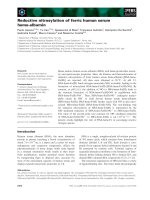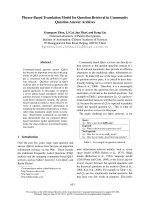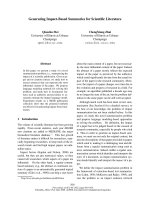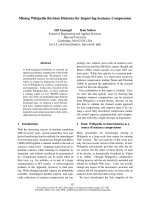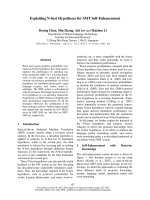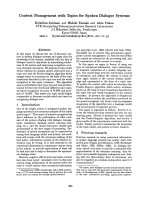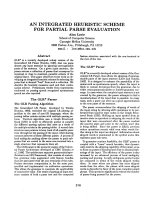Báo cáo khoa học: "Splitting Complex Temporal Questions for Question Answering systems" doc
Bạn đang xem bản rút gọn của tài liệu. Xem và tải ngay bản đầy đủ của tài liệu tại đây (166.67 KB, 8 trang )
Splitting Complex Temporal Questions for Question Answering systems
E. Saquete, P. Mart
´
ınez-Barco, R. Mu
˜
noz, J.L. Vicedo
Grupo de investigaci´on del Procesamiento del Lenguaje y Sistemas de Informaci´on.
Departamento de Lenguajes y Sistemas Inform´aticos. Universidad de Alicante.
Alicante, Spain
stela,patricio,rafael,vicedo @dlsi.ua.es
Abstract
This paper presents a multi-layered Question An-
swering (Q.A.) architecture suitable for enhanc-
ing current Q.A. capabilities with the possibility of
processing complex questions. That is, questions
whose answer needs to be gathered from pieces
of factual information scattered in different docu-
ments. Specifically, we have designed a layer ori-
ented to process the different types of temporal
questions. Complex temporal questions are first de-
composed into simpler ones, according to the tem-
poral relationships expressed in the original ques-
tion.
In the same way, the answers of each simple ques-
tion are re-composed, fulfilling the temporal restric-
tions of the original complex question.
Using this architecture, a Temporal Q.A. system
has been developed.
In this paper, we focus on explaining the first part
of the process: the decomposition of the complex
questions. Furthermore, it has been evaluated with
the TERQASquestion corpus of 112 temporal ques-
tions. For the task of question splitting our system
has performed, in terms of precision and recall, 85%
and 71%, respectively.
1 Introduction
Question Answering could be defined as the pro-
cess of computer-answering to precise or arbitrary
questions formulated by users. Q.A. systems are es-
pecially useful to obtain a specific piece of informa-
tion without the need of manually going through all
the available documentation related to the topic.
Research in Question Answering mainly focuses
on the treatment of factual questions. These require
as an answer very specific items of data, such as
dates, names of entities or quantities, e.g., “What is
the capital of Brazil?”.
This paper has been supported by the Spanish government,
projects FIT-150500-2002-244, FIT-150500-2002-416, TIC-
2003-07158-C04-01 and TIC2000-0664-C02-02.
Temporal Q.A. is not a trivial task due to the com-
plexity temporal questions may reach. Current op-
erational Q.A. systems can deal with simple factual
temporal questions. That is, questions requiring to
be answered with a date, e.g. “When did Bob Mar-
ley die?”. or questions that include simple temporal
expressions in their formulation, e.g., “Who won the
U.S. Open in 1999?”. Processing this sort of ques-
tions is usually performed by identifying explicit
temporal expressions in questions and relevant doc-
uments, in order to gather the necessary information
to answer the queries.
Even though, it seems necessary to emphasize
that the system described in (Breck et al., 2000) is
the only one also using implicit temporal expression
recognition for Q.A. purposes. It does so by apply-
ing the temporal tagger developed by Mani and Wil-
son (2000).
However, issues like addressing the temporal
properties or the ordering of events in questions, re-
main beyond the scope of current Q.A. systems:
“Who was spokesman of the Soviet Embassy
in Baghdad during the invasion of Kuwait?”
“Is Bill Clinton currently the President of the
United States?”
This work presents a Question Answering system
capable of answering complex temporal questions.
This approach tries to imitate human behavior when
responding this type of questions. For example, a
human that wants to answer the question: “Who
was spokesman of the Soviet Embassy in Baghdad
during the invasion of Kuwait?” would follow this
process:
1. First, he would decompose this question into
two simpler ones: “Who was spokesman of the
Soviet Embassy in Baghdad?” and “When did
the invasion of Kuwait occur?”.
2. He would look for all the possible answers
to the first simple question: “Who was
spokesman of the Soviet Embassy in Bagh-
dad?”.
3. After that, he would look for the answer to the
second simple question: “When did the inva-
sion of Kuwait occur?”
4. Finally, he would give as a final answer one
of the answers to the first question (if there is
any), whose associated date stays within the
period of dates implied by the answer to the
second question. That is, he would obtain
the final answer by discarding all answers to
the simple questions which do not accomplish
the restrictions imposed by the temporal signal
provided by the original question (during).
Therefore, the treatment of complex question is
based on the decomposition of these questions into
simpler ones, to be resolved using conventional
Question Answering systems. Answers to simple
questions are used to build the answer to the origi-
nal question.
This paper has been structured in the following
fashion: first of all, section 2 presents our proposal
of a taxonomy for temporal questions. Section 3
describes the general architecture of our temporal
Q.A. system. Section 4 deepens into the first part
of the system: the decomposition unit. Finally, the
evaluation of the decomposition unit and some con-
clusions are shown.
2 Proposal of a Temporal Questions
Taxonomy
Before explaining how to answer temporal ques-
tions, it is necessary to classify them, since the
way to solve them will be different in each case.
Our classification distinguishes first between simple
questions and complex questions. We will consider
as simple those questions that can be solved directly
by a current General Purpose Question Answering
system, since they are formed by a single event. On
the other hand, we will consider as complex those
questions that are formed by more than one event
related by a temporal signal which establishes an
order relation between these events.
Simple Temporal Questions:
Type 1: Single event temporal questions without
temporal expression (TE). This kind of questions
are formed by a single event and can be directly
resolved by a Q.A. System, without pre- or post-
processing them. There are not temporal expres-
sions in the question. Example: “When did Jordan
close the port of Aqaba to Kuwait?”
Type 2: Single event temporal questions with tem-
poral expression. There is a single event in the ques-
tion, but there are one or more temporal expressions
that need to be recognized, resolved and annotated.
Each piece of temporal information could help to
search for an answer. Example: “Who won the 1988
New Hampshire republican primary?”. TE: 1988
Complex Temporal Questions:
Type 3: Multiple events temporal questions with
temporal expression. Questions that contain two or
more events, related by a temporal signal. This sig-
nal establishes the order between the events in the
question. Moreover, there are one or more tempo-
ral expressions in the question. These temporal ex-
pressions need to be recognized, resolved and an-
notated, and they introduce temporal constraints to
the answers of the question. Example: “What did
George Bush do after the U.N. Security Council or-
dered a global embargo on trade with Iraq in August
90?” In this example, the temporal signal is after
and the temporal constraint is “between 8/1/1990
and 8/31/1990”. This question can be divided into
the following ones:
Q1: What did George Bush do?
Q2: When the U.N. Security Council ordered
a global embargo on trade with Iraq?
Type 4: Multiple events temporal questions with-
out temporal expression. Questions that consist
of two or more events, related by a temporal sig-
nal. This signal establishes the order between the
events in the question. Example: “What happened
to world oil prices after the Iraqi annexation of
Kuwait?”. In this example, the temporal signal is
after and the question would be decomposed into:
Q1: What happened to world oil prices?
Q2: When did the Iraqi “annexation” of
Kuwait occur?
How to process each type will be explained in de-
tail in the following sections.
3 Multi-layered Question-Answering
System Architecture
Current Question Answering system architectures
do not allow to process complex questions. That is,
questions whose answer needs to be gathered from
pieces of factual information that is scattered in a
document or through different documents. In or-
der to be able to process these complex questions,
we propose a multi-layered architecture. This ar-
chitecture increases the functionality of the current
Question-Answering systems, allowing us to solve
any type of temporal questions. Moreover, this sys-
tem could be easily augmented with new layers to
cope with questions that need complex processing
and are not temporal oriented.
Some examples of complex questions are:
Temporal questions like “Where did Michael
Milken study before going to the University of
Pennsylvania?”. This kind of questions needs
to use temporal information and event ordering
to obtain the right answer.
Script questions like “How do I assemble a bi-
cycle?”. In these questions, the final answer is
a set of ordered answers.
Template-based questions like “Which are the
main biographical data of Nelson Mandela?”.
This question should be divided in a number of
factual questions asking for different aspects of
Nelson Mandela’s biography. Gathering their
respective answers will make it possible to an-
swer the original question.
These three types of question have in common
the necessity of an additional processing in order
to be solved. Our proposal to deal with them is
to superpose an additional processing layer, one by
each type, to a current General Purpose Question
Answering system, as it is shown in Figure 1. This
layer will perform the following steps:
Decomposition of the question into simple
events to generate simple questions (sub-
questions) and the ordering of the sub-
questions.
Sending simple questions to a current General
Purpose Question Answering system.
Receiving the answers to the simple questions
from the current General Purpose Question
Answering system.
Filtering and comparison between sub-answers
to build the final complex answer.
!
Figure 1: Multi-layered Architecture of a Q.A.
The main advantages of performing this multi-
layered system are:
It allows you to use any existing general Q.A.
system, with the only effort of adapting the
output of the processing layer to the type of
input that the Q.A. system uses.
Due to the fact that the process of complex
questions is performed at an upper layer, it is
not necessary to modify the Q.A. system when
you want to deal with more complex questions.
Each additional processing layer is indepen-
dent from each other and only processes those
questions within the type accepted by that
layer.
Next, we present a layer oriented to process tem-
poral questions according to the taxonomy shown in
section 2.
3.1 Architecture of a Question Answering
System applied to Temporality
The main components of the Temporal Question
Answering System are (c.f. figure 2) top-down:
Question Decomposition Unit, General purpose
Q.A. system and Answer, Recomposition Unit.
!
!
"""
"""
"""
Figure 2: Temporal Question Answering System
These components work all together for the ob-
tainment of a final answer. The Question Decom-
position Unit and the Answer Recomposition Unit
are the units that conform the Temporal Q.A. layer
which process the temporal questions, before and
after using a General Purpose Q.A. system.
The Question Decomposition Unit is a prepro-
cessing unit which performs three main tasks.
First of all, the recognition and resolution of
temporal expressions in the question. Sec-
ondly, there are different types of questions,
according to the taxonomy shown in section 2.
Each type of them needs to be treated in a dif-
ferent manner. For this reason, type identifica-
tion must be done. After that, complex ques-
tions of types 3 and 4 only, are split into sim-
ple ones, which are used as the input of a Gen-
eral Purpose Question-Answering system. For
example, the question “Where did Bill Clinton
study before going to Oxford University?”, is
divided into two sub-questions related through
the temporal signal before:
– Q1: Where did Bill Clinton study?
– Q2: When did Bill Clinton go to Oxford
University?
A General Purpose Question Answering sys-
tem. Simple factual questions generated are
processed by a General Purpose Question An-
swering system. Any Question Answering sys-
tem could be used here. In this case, the
SEMQA system (Vicedo and Ferr´andez, 2000)
has been used. The only condition is to know
the output format of the Q.A. system to accord-
ingly adapt the layer interface. For the exam-
ple above, a current Q.A. system returns the
following answers:
– Q1 Answers: Georgetown University
(1964-68) // Oxford University (1968-70)
// Yale Law School (1970-73)
– Q2 Answer: 1968
The Answer Recomposition Unit is the last
stage in the process. This unit builds the an-
swer to the original question from the answers
to the sub-questions and the temporal infor-
mation extracted from the questions (temporal
signals or temporal expressions). As a result,
the correct answer to the original question is
returned.
Apart from proposing a taxonomy of tem-
poral questions, we have presented a multi-
layered Q.A. architecture suitable for enhanc-
ing current Q.A. capabilities with the possibil-
ity of adding new layers for processing differ-
ent kinds of complex questions. Moreover, we
have proposed a specific layer oriented to pro-
cess each type of temporal questions.
The final goal of this paper is to introduce and
evaluate the first part of the temporal question
processing layer: the Question Decomposition
Unit.
Next section shows the different parts of the unit
together with some examples of their behavior.
4 Question Decomposition Unit
The main task of this unit is the decomposition of
the question, which is divided in three main tasks or
modules:
Type Identification (according to the taxonomy
proposed in section 2)
Temporal Expression Recognition and Resolu-
tion
Question Splitter
These modules are fully explained below. Once
the decomposition of the question has been made,
the output of this unit is:
A set of sub-questions, that are the input of the
General Purpose Question-Answering system.
Temporal tags, containing concrete dates re-
turned by TERSEO system (Saquete et al.,
2003), that are part of the input of the Answer
Recomposition Unit and are used by this unit
as temporal constraints in order to filter the in-
dividual answers.
A set of temporal signals that are part of the in-
put of the Answer Recomposition Unit as well,
because this information is necessary in order
to compose the final answer.
Once the decomposition has been made, the General
Purpose Question-Answering system is used to treat
with simple questions. The temporal information
goes directly to the Answer Recomposition unit.
4.1 Type Identification
The Type Identification Unit classifies the question
in one of the four types of the taxonomy proposed in
section 2. This identification is necessary because
each type of question causes a different behavior
(scenario) in the system. Type 1 and Type 2 ques-
tions are classified as simple, and the answer can
be obtained without splitting the original question.
However, Type 3 and Type 4 questions need to be
split in a set of simple sub-questions. The types of
these sub-questions are always Type 1 or Type 2 or
a non-temporal question, which are considered sim-
ple questions.
The question type is established according to the
rules in figure 3:
Figure 3: Decision tree for Type Identification
4.2 Temporal Expression Recognition and
Resolution
This module uses TERSEO system (Saquete et al.,
2003) to recognize, annotate and resolve temporal
expressions in the question. The tags this module
returns exhibit the following structure:
Explicit dates:
<DATE_TIME ID="value" TYPE="value"
VALDATE1="value"VALTIME1="value"
VALDATE2="value" VALTIME2="value">
expression </DATE_TIME>
Implicit dates:
<DATE_TIME_REF ID="value" TYPE="value"
VALDATE1="value"VALTIME1="value"
VALDATE2="value" VALTIME2="value">
expression </DATE_TIME_REF>
Every expression is identified by a numeric ID.
VALDATE# and VALTIME# store the range of
dates and times obtained from the system, where
VALDATE2 and VALTIME2 are only used to es-
tablish ranges. Furthermore, VALTIME1 could be
omitted if a single date is specified. VALDATE2,
VALTIME1 and VALTIME2 are optional attributes.
These temporal tags are the output of this mod-
ule and they are used in the Answer Recomposi-
tion Unit in order to filter the individual answers ob-
tained by the General Purpose Question-Answering
system. The tags are working as temporal con-
straints.
Following, a working example is introduced.
Given the next question “Which U.S. ship was at-
tacked by Israeli forces during the Six Day war in
the sixties?”:
1. Firstly, the unit recognizes the temporal ex-
pression in the question, resolves and tags it,
resulting in:
<DATETIMEREF valdate1="01/01/1960"
valdate2="31/12/1969"> in the
sixties </DATETIMEREF>
2. The temporal constraint is that the date of the
answers should be between the values valdate1
and valdate2.
4.3 Question Splitter
This task is only necessary when the type of the
question, obtained by the Type Identification Mod-
ule, is 3 or 4. These questions are considered com-
plex questions and need to be divided into simple
ones (Type 1, Type 2). The decomposition of a
complex question is based on the identification of
temporal signals, which relate simple events in the
question and establish an order between the answers
of the sub-questions. Finally, these signals are the
output of this module and are described in next sub-
section.
4.3.1 Temporal Signals
Temporal signals denote the relationship between
the dates of the related events. Assuming that F1
is the date related to the first event in the question
and F2 is the date related to the second event, the
signal will establish an order between them. This
we have named the ordering key. An example of
some ordering keys is introduced in table 1.
SIGNAL ORDERING KEY
After F1 > F2
When F1 = F2
Before F1 < F2
During F2i <= F1 <=
F2f
From F2 to F3 F2 <= F1 <= F3
About F2 F3 F2 <= F1 <= F3
On / in F1 = F2
While F2i <= F1 <=
F2f
For F2i <= F1 <=
F2f
At the time of F1 = F2
Since F1 > F2
Table 1: Example of signals and ordering keys
4.3.2 Implementation
One have divided each complex question into two
parts, based on the temporal signal. The former
is a simple question, therefore, no transformation
is required. However, the latter (the bit after the
temporal signal) needs transformation into a correct
question pattern, always corresponding to a “When”
type-question. Moreover, three different kinds of
question structures have been determined, being the
transformation different for each of them. The im-
plementation of this module is shown in figure 4.
!!"#
$%
&
&
"'(!)
%*)+),
,#'
*)
+),,#'
Figure 4: Decision tree for the Question Splitter
The three possible cases are:
The question that follows the temporal sig-
nal does not contain any verb, for example:
“What happened to the world oil prices af-
ter the Iraqi annexation of Kuwait?” In this
case, our system returns the following trans-
formation: “When did the Iraqi annexation of
Kuwait occur?” This case is the simplest,
since the only transformation needed is adding
the words “When did occur?” to the second
sentence.
The question that follows the temporal signal
contains a verb, but this verb is a gerund tense,
for example: “Where did Bill Clinton study
before going to Oxford University?” In this
case two previous steps to the transformation
are necessary:
1. Extracting the subject of the previous
question.
2. Converting the verb of the second sen-
tence to infinitive tense.
The final question returned by the system is:
“When did Bill Clinton go to Oxford Univer-
sity?”.
In the last type of transformation the second
sentence in the question contains a tensed verb
and its own subject, e.g., “What did George
Bush do after the U.N. Security Council or-
dered a global embargo on trade with Iraq?”
In this case, the infinitive and the tense of the
sentence are obtained. Hence, the question re-
sults in the following form: “When did the
U.N. Security Council order a global embargo
on trade with Iraq?”.
4.3.3 Example
In the following example a part of the returned file
of our Decomposition Unit is shown.
1.Where did Bill Clinton study before
going to Oxford University?
Temporal Signal: before
Q1: Where did Bill Clinton study?
Q2: When did Bill Clinton go to
Oxford University?
2.What did George Bush do after the
U.N. Security Council ordered a
global embargo on trade with Iraq
in August 90?
Temporal Signal: after
Temporal Expression: in August 90
Q1: What did George Bush do?
Q2: When did the U.N. Security
Council order a global embargo
on trade with Iraq in August 90?
DateQ2:[01/08/1990 31/08/1990]
3.When did Iraq invade Kuwait?
Temporal Signal: -
Temporal Expression: -
Q1: When did Iraq invade Kuwait?
4.Who became governor of New Hampshire
in 1949?
Temporal Signal: -
Temporal Expression: in 1949
Q1: Who became governor of New
Hampshire in 1949?
DateQ1:[01/01/1949 31/12/1949]
4.4 Decomposition Unit Evaluation
This section presents an evaluation of the Decompo-
sition Unit for the treatment of complex questions.
For the evaluation a corpus of questions containing
as many simple as complex questions is required.
Due to the fact that question corpora used in TREC
(TREC, ) and CLEF (CLEF, ) do not contain com-
plex questions, the TERQAS question corpus has
been chosen (Radev and Sundheim, 2002; Puste-
jovsky, 2002). It consists of 123 temporal questions.
TOTAL TREATED SUCCESSES PRECISION RECALL F-
MEASURE
TE Recognition and Resolu-
tion
62 52 47 90% 75% 86%
Type Identification 112 112 104 92% 100% 93%
Signal Detection 17 14 14 100% 82% 95%
Question Splitter 17 14 12 85% 71% 81%
DECOMPOSITION UNIT 112 112 93 83% 83% 83%
Table 2: Evaluation of the system
From these, 11 were discarded due to requiring the
need of a treatment beyond the capabilities of the
system introduced hereby. Questions of the type:
“Who was the second man on the moon” can not
be answered by applying the question decomposi-
tion. They need a special treatment. For the afore-
mentioned phrase, this would consist of obtaining
the names of all the men having been on the moon,
ordering the dates and picking the second in the or-
dered list of names.
Therefore, for this evaluation, we have just been
focusing on trying to resolve the 112 left. The eval-
uation has been made manually by three annotators.
Four different aspects of the unit have been consid-
ered:
Recognition and resolution of Temporal Ex-
pressions: In this corpus, there were 62 tem-
poral expressions and our system was able to
recognize 52, from which 47 were properly re-
solved by this module.
Type Identification: There were 112 temporal
questions in the corpus. Each of them was pro-
cessed by the module, resulting in 104 properly
identified according to the taxonomy proposed
in section 2.
Signal Detection: In the corpus, there were 17
questions that were considered complex (Type
3 and Type 4). Our system was able to treat
and recognize correctly the temporal signal of
14 of these questions.
Question Splitter: From this set of 17 complex
questions, the system was able to process 14
questions and divided properly 12 of them.
The results, in terms of precision and recall are
shown in Table 2. In the evaluation, only 19 ques-
tions are wrongly pre-processed. Errors provoking
a wrong pre-processing have been analyzed thor-
oughly:
There were 8 errors in the identification of the
type of the question and they were due to:
– Not treated TE or wrong TE recognition:
6 questions.
– Wrong Temporal Signal detection: 2
questions.
There were 5 errors in the Question Splitter
module:
– Wrong Temporal Signal detection: 3
questions.
– Syntactic parser problems: 2 questions.
There were 15 errors not affecting the treat-
ment of the question by the General Purpose
Question Answering system. Nevertheless,
they do affect the recomposition of the final an-
swer. They are due to:
– Not treated TE or wrong TE recognition:
6 questions.
– Wrong temporal expression resolution: 9
questions.
Some of these questions provoke more than one
problem, causing that both, type identification and
division turn to be wrong.
5 Conclusions
This paper presents a new and intuitive method
for answering complex temporal questions using
an embedded current factual-based Q.A. system.
The method proposed is based on a new procedure
for the decomposition of temporal questions, where
complex questions are divided into simpler ones by
means of the detection of temporal signals. The
TERSEO system, a temporal information extraction
system applied to event ordering has been used to
detect and resolve temporal expressions in questions
and answers.
Moreover, this work proposes a new multi-
layered architecture that enables to solve complex
questions by enhancing current Q.A. capabilities.
The multi-layered approach can be applied to any
kind of complex questions that allow question de-
composition such as script questions, e.g., “How do
I assemble a bicycle?”, or template-like questions,
e.g., “Which are the main biographical data of Nel-
son Mandela?”.
This paper has specifically focused on a process
of decomposition of complex temporal questions
and on its evaluation on a temporal question corpus.
In the future, our work is directed to fine tune this
system and increase its capabilities towards process-
ing questions of higher complexity.
References
E. Breck, J. Burger, L. Ferro, W. Greiff, M. Light,
I. Mani, and J. Rennie. 2000. Another sys called
quanda. In Ninth Text REtrieval Conference, vol-
ume 500-249 of NIST Special Publication, pages
369–378, Gaithersburg, USA, nov. National In-
stitute of Standards and Technology.
CLEF. Cross-language evaluation forum.
/>I. Mani and G. Wilson. 2000. Robust temporal pro-
cessing of news. In ACL, editor, Proceedings of
the 38th Meeting of the Association of Computa-
tional Linguistics (ACL 2000), Hong Kong, Oc-
tober.
J. Pustejovsky. 2002. Terqas:time and event
recognition for question answering systems.
/>D. Radev and B. Sundheim. 2002. Us-
ing timeml in question answering.
/>˜
jamesp/ arda/ time/
documentation/
TimeML-use-in-qa-v1.0.pdf.
E. Saquete, R. Mu¯noz, and P. Mart´ınez-Barco.
2003. Terseo: Temporal expression resolution
system applied to event ordering. In TSD, ed-
itor, Proceedings of the 6th International Con-
ference ,TSD 2003, Text, Speech and Dialogue,
pages 220–228, Ceske Budejovice,Czech Repub-
lic, September.
TREC. Text retrieval conference.
/>J. L. Vicedo and A. Ferr´andez. 2000. A seman-
tic approach to question answering systems. In
Ninth Text REtrieval Conference, volume 500-
249 of NIST Special Publication, pages 13–16,
Gaithersburg, USA, nov. National Institute of
Standards and Technology.

